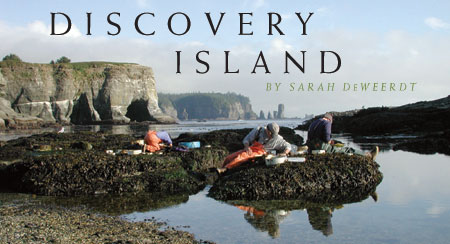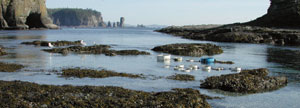

On Tatoosh, Paine set up an experiment with six kinds of mollusks and a sea urchin, examining the effect of these grazers on the intertidal seaweeds they eat. When it was over, he had created an equation that, for the first time, allowed scientists to make quantitative, objective comparisons in nature between different species that could be applied to different ecosystems.
That study also suggested that only a few species are strong; most species are weak interactors. Researchers have found a similar pattern in other environments, and it is becoming accepted as a general rule of ecosystems.
For land managers and conservation biologists, such work has enormous implications. “If you want to fix a system then you have to know who the strong and weak interactors are,” Paine says.

If individual species are important, it means they are worth saving. We lose something, ecologically, when we dumb-down ecosystems, disrupting the intricate relationships between species that have developed over the course of eons. At the same time, if there are only a few strongly interacting species, maybe we don’t have to know everything about an ecosystem before we can save it.
This work builds on the idea that first launched Paine to prominence in his field—the keystone species (see sidebar), which he proposed in 1969. Just as a keystone in an arch holds the other stones in place, a single species may have a disproportionate effect on the structure of an ecological community.
The concept was based on a shorter starfish-removal experiment he had done on the west coast of the Olympic Peninsula. When he removed the ochre sea star from a section of the rocky shore, he found—as he would later demonstrate even more dramatically on Tatoosh—that the normal intertidal community collapsed. Without the starfish to keep them in check, mussels quickly took over and left little room for anything else. Keystones may not be large or abundant, but the consequences of their loss are enormous.
The keystone species concept has generated controversy over the years, but it has also increased understanding of ecosystems and aided wildlife management. For example, the concept guided the reintroduction of wolves into Yellowstone National Park, as managers recognized that by controlling the populations of elk and other grazers, wolves might do more to promote the overall health of the ecosystem than perhaps any other species.

Paine is now 72 and, technically, retired, but he is not resting on his laurels. These days, his trips to the island usually coincide with those of Tim Wootton and Cathy Pfister, former graduate students who are now professors at the University of Chicago. Since Paine’s retirement, they’ve begun to handle most of the logistics—arranging for transportation, making sure the buildings are maintained.
Paine has continued to publish regularly, predominantly in top scientific journals. And he still teaches—now in collaboration with Jennifer Ruesink, a former graduate student who is now a professor in the UW biology department—the long-running graduate seminar known affectionately as “Paine-bull.”
He makes about 10 trips per year to Tatoosh, spending a total of 40 to 45 days in the field—less than he used to, but still enough to maintain an active research program.
These days, he’s continuing to monitor the Glacier to see how the intertidal community will change now that he’s stopped removing the starfish from the mussel bed. He is also studying a series of rocky platforms where the 1997–98 El Niño eliminated a stand of seaweed, leading to a surprising replacement by mussels.
“If you remove a perturbing influence, will the system recover, and how long will it take?” Paine asks. In a time when human activities cause profound alterations to ecosystems, his work continues to tackle some of the most fundamental questions about our relationship to the natural world.
Sarah DeWeerdt is a free-lance science writer based in Seattle.
All photos by Alan Trimble except the aerial shot of Tatoosh Island, courtesy of the Washington Department of Ecology.
Go To: Page 1 | Page 2 | Page 3